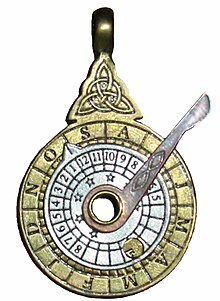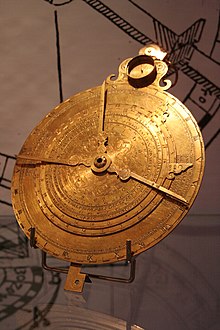174:
20:
454:
202:
478:
442:
466:
193:
sometimes extended beyond the rim. The axis, or pivot point, must be such that a star can be sighted through it; usually a hollow rivet is used. Since the instrument is used at night, markings may be exaggerated or raised. Often the inner disc has a diagram of the necessary constellations and stars, to aid in locating them.
23:
A nocturnal as costume jewellery. This is a functioning nocturnal, though only about 5 cm tall. It shows the month ring on the outside in brass. The silver coloured inner disk shows the time and has an indicator on one edge. By setting the indicator to the month and day (in this case, a few days into
192:
A nocturnal will have an outer disc marked with the months of the year, and an inner disc marked with hours (and perhaps half hours, or quarter hours on the largest instruments) as well as locations for one or more reference stars. It will also have a pointer rotating on the same axis as the discs,
255:
The inner disc is rotated so that the mark for the chosen reference star points to the current date on the outer disc. The north star is sighted through the center of the device, and the pointer arm is rotated to point at the chosen reference star. The intersection of the pointer arm with the hour
126:
Even if the nightly course of the stars has been known since antiquity, mentions of a dedicated instrument for its measurement are not found before the Middle Ages. The earliest image presenting the use of a nocturnal is in a manuscript dated from the 12th century.
24:
October), centring
Polaris in the hole in the middle and rotating the pointer attached to the centre to a specified circumpolar star, the arm indicates the time (in this case, 8 pm).
256:
markings on the inner disc indicates the time. The instrument must be held upright, and should have a handle or similar hint as to which direction is down.
508:
425:
388:
76:
requires a correction of this giant clock based on the date of observation, and nocturnal helps to apply this correction.
221:, all stars will appear to rotate about the North Star during the night, and their positions, like the progress of the
503:
371:
280:
498:
413:
267:. Similarly, it is not possible to determine longitude unless the observer also knows the standard time from a
143:
213:, made of two or more dials, that will provide the local time based on the time of year and a sighting of
64:
makes a full revolution around the pole star in 23 hours and 56 minutes and therefore can be used as an
432:
249:
225:, can be used to determine the time. The positions of the stars will change based on the time of year.
33:
16:
Instrument to determine local time using relative positions of two or more stars in the night sky
96:
419:
8:
482:
218:
165:
with a widely circulated illustration of the instrument while being used by an observer.
120:
57:
470:
119:, a precursor for the later nocturnal instruments, was invented in the 9th century by
367:
268:
446:
349:, vol.1, Chap. 36, par.30, Mainz, 1721; Earlier Lull mentions the nocturnal in his
210:
458:
252:
may also be used, since it is on the opposite side of the sky from Ursa Major.
154:
492:
285:
241:
173:
162:
41:
150:, published in 1551 the name and the instrument gained a larger popularity.
128:
87:(in French and occasionally used by English writers), it is related to the
73:
19:
259:
It is not possible to convert the local time to a standard time such as
233:
229:
104:
61:
37:
453:
228:
The most commonly used reference stars are the pointer stars from the
264:
88:
69:
65:
53:
49:
332:, "La Busca de Paper" n. 22, Primavera, p. 3-12 (edicion bilingue)
201:
245:
214:
92:
237:
186:
182:
100:
45:
260:
222:
217:, the North Star, and one or more other stars. In the
430:
310:
298:
181:Nocturnals have been most commonly constructed of
490:
396:Bulletin of the Scientific Instrument Society
263:without accurate knowledge of the observer's
422:– Video and description, also, many devices
416:– Nocturnal from an astrological compendium
386:
330:La Sphaera Horarum Noctis de Ramon Llull
316:
304:
200:
172:
18:
491:
68:. The 4-minute difference between the
356:
322:
362:Harriet Wynter and Anthony Turner,
95:. Knowing the time is important in
13:
131:repeatedly described the use of a
14:
520:
509:Historical scientific instruments
407:
389:"On the History of the Nocturnal"
153:It was described also c. 1530 by
476:
464:
452:
440:
426:A working nocturnal in coin form
281:List of astronomical instruments
205:Operating scheme of a nocturnal.
103:and some nocturnals incorporate
168:
83:(time instrument for night) or
335:
1:
291:
7:
343:Liber Principorum medicinae
274:
177:A nocturnal made in Vienna.
10:
525:
387:Oestmann, Günther (2001).
380:
328:Farre i Olive E., (1996):
110:
504:Astronomical instruments
209:A nocturnal is a simple
196:
144:Martín Cortés de Albacar
366:, Studio Vista, 1975,
244:(Ursa Minor). The star
161:, republished later by
499:Navigational equipment
364:Scientific Instruments
206:
178:
133:sphaera horarum noctis
36:used to determine the
25:
204:
176:
137:astrolabium nocturnum
107:for important ports.
56:. As a result of the
22:
159:Cosmographicus Liber
117:horologium nocturnum
81:horologium nocturnum
219:northern hemisphere
121:Pacificus of Verona
79:Sometimes called a
207:
179:
26:
516:
481:
480:
479:
469:
468:
467:
457:
456:
445:
444:
443:
436:
403:
393:
374:
360:
354:
339:
333:
326:
320:
314:
308:
302:
99:for calculating
58:Earth's rotation
52:relative to the
524:
523:
519:
518:
517:
515:
514:
513:
489:
488:
487:
477:
475:
465:
463:
451:
441:
439:
431:
410:
391:
383:
378:
377:
361:
357:
340:
336:
327:
323:
315:
311:
303:
299:
294:
277:
211:analog computer
199:
171:
148:Arte de Navegar
113:
17:
12:
11:
5:
522:
512:
511:
506:
501:
486:
485:
473:
461:
449:
429:
428:
423:
417:
414:British Museum
409:
408:External links
406:
405:
404:
382:
379:
376:
375:
355:
351:Nova geometria
334:
321:
309:
296:
295:
293:
290:
289:
288:
283:
276:
273:
198:
195:
170:
167:
155:Petrus Apianus
112:
109:
15:
9:
6:
4:
3:
2:
521:
510:
507:
505:
502:
500:
497:
496:
494:
484:
474:
472:
462:
460:
455:
450:
448:
438:
437:
434:
427:
424:
421:
418:
415:
412:
411:
401:
397:
390:
385:
384:
373:
372:0-289-70403-0
369:
365:
359:
352:
348:
344:
341:Raimon Lull,
338:
331:
325:
318:
317:Oestmann 2001
313:
306:
305:Oestmann 2001
301:
297:
287:
286:Sidereal time
284:
282:
279:
278:
272:
270:
266:
262:
257:
253:
251:
247:
243:
242:Little Dipper
239:
235:
231:
226:
224:
220:
216:
212:
203:
194:
190:
188:
184:
175:
166:
164:
163:Gemma Frisius
160:
156:
151:
149:
145:
140:
138:
134:
130:
124:
122:
118:
108:
106:
102:
98:
94:
90:
86:
82:
77:
75:
71:
67:
63:
59:
55:
51:
47:
43:
40:based on the
39:
35:
31:
21:
483:Solar System
399:
395:
363:
358:
350:
346:
342:
337:
329:
324:
319:, p. 6.
312:
307:, p. 5.
300:
258:
254:
227:
208:
191:
180:
169:Construction
158:
152:
147:
141:
136:
132:
129:Raymond Lull
125:
116:
114:
84:
80:
78:
74:sidereal day
29:
27:
471:Outer space
347:Opera omnia
269:chronometer
115:The actual
105:tide charts
493:Categories
420:Simulation
292:References
250:Cassiopeia
234:Ursa Major
230:Big Dipper
85:nocturlabe
62:fixed star
38:local time
34:instrument
447:Astronomy
265:longitude
240:from the
146:'s book
89:astrolabe
70:solar day
66:hour hand
54:pole star
50:night sky
30:nocturnal
275:See also
97:piloting
42:position
459:Science
433:Portals
381:Sources
353:(1299).
246:Schedar
215:Polaris
157:in his
111:History
93:sundial
48:in the
402:: 5–9.
370:
238:Kochab
142:With
60:, any
32:is an
392:(PDF)
236:) or
197:Usage
187:brass
101:tides
44:of a
368:ISBN
183:wood
91:and
72:and
46:star
345:in
261:UTC
248:in
223:sun
185:or
135:or
495::
400:69
398:.
394:.
271:.
189:.
139:.
123:.
28:A
435::
232:(
Text is available under the Creative Commons Attribution-ShareAlike License. Additional terms may apply.


